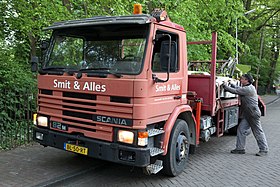
DAF Trucks is a Dutch truck manufacturing company and a division of Paccar. DAF originally stood for van Doorne's Aanhangwagen Fabriek. Its headquarters and main plant are in Eindhoven. Cabs and axle assemblies are produced at its Westerlo plant in Belgium. Some of the truck models sold with the DAF brand are designed and built by Leyland Trucks at its Leyland plant in the United Kingdom.

Scania AB is a major Swedish manufacturer headquartered in Södertälje, focusing on commercial vehicles—specifically heavy lorries, trucks and buses. It also manufactures diesel engines for heavy vehicles as well as marine and general industrial applications.

Leyland Motors Limited was a British vehicle manufacturer of lorries, buses and trolleybuses. The company diversified into car manufacturing with its acquisitions of Triumph and Rover in 1960 and 1967, respectively. It gave its name to the British Leyland Motor Corporation, formed when it merged with British Motor Holdings in 1968, to become British Leyland after being nationalised. British Leyland later changed its name to simply BL, then in 1986 to Rover Group.

The Renault Master is a large van produced by the French manufacturer Renault since 1980, now in its third generation. It replaced the earlier Renault Super Goélette light trucks. Opel has sold versions of the second and third series vans as the Opel Movano in Continental Europe and Vauxhall Movano in the United Kingdom. All three generations have been designed and manufactured by Renault, irrespective of the brand. Renault Trucks markets it as the Renault Trucks Master.

The medium-duty version of the Ford F-Series is a range of commercial trucks manufactured by Ford since 1948. Derived from the smaller F-Series pickup trucks, the medium-duty range is currently in its eighth generation. Initially slotted between the F-Series pickup trucks and the "Big Job" conventionals, later generations were slotted below the L-Series "Louisville" trucks; the last two generations are the largest vehicles produced by Ford since its exit from the heavy-truck segment.

The Volvo FL is a series of trucks manufactured by Volvo Trucks. It was introduced in 1985 and has remained in production ever since, in a variety of different models of different weight ratings. It has been used in a variety of different roles aside from a truck, including as a fire engine.
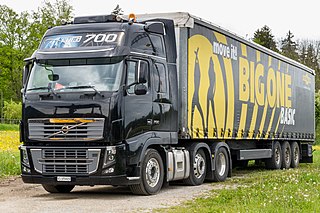
Cab-over, also known as cab over engine (COE), cab forward (U.S.), flat nose (Canada), or forward control (UK), is a body style of truck, bus, or van that has a vertical front, "flat face" or a semi-hood, with the cab of the truck sitting above the front axle. This contrasts with a conventional truck where the engine is mounted in front of the driver.

The Isuzu Elf is a medium duty truck produced by Isuzu since 1959. Outside Japan it is known as N series and Q Series. The range was originally mainly available in Japan and other Asian countries. Australia was another important market for the Elf and N series – to the extent that it was manufactured there from the 1970s using many local components. Since the early 1980s, it has also been sold and built in the United States, and also as the Isuzu N-Series. Only North America receives the wide-cab version.
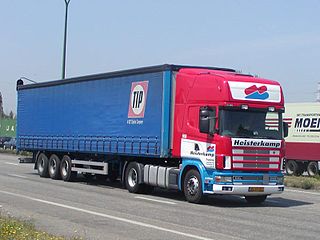
The Scania 4-series, is a truck model range which was introduced by Scania in 1995. It was the successor of the 3-series and it came in five engine combinations, three cabs and four chassis types. The 4-series was succeeded by the PRT-range in Europe in 2004, but production continued in Brazil until 2007.

The Scania 4-series low floor city bus and coach range was introduced by Scania in 1997 as a successor to the 3-series bus range.

The Scania-Vabis L55/L56/L66 was a series of trucks produced by Swedish automaker Scania-Vabis between 1959 and 1968.
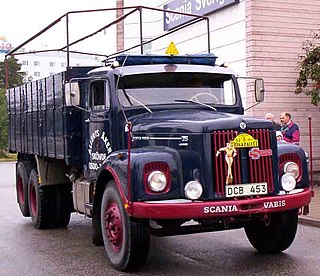
The Scania-Vabis L75/L76 was a series of heavy duty trucks produced by Swedish automaker Scania-Vabis between 1958 and 1968.
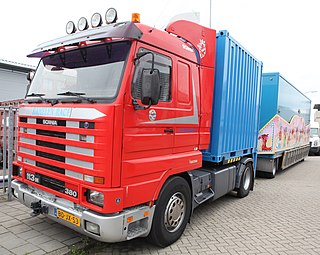
The Scania 3-series is a truck model range introduced in 1987 by Swedish truck manufacturer Scania. It is the successor of the 2-series.The 3 series came in a range of different engine sizes and horsepower from 9.0 litre 230 horsepower all the way up to 14 litre V8 500 horsepower engine. Production of the 3-series was stopped after the 4-series were introduced in 1995. The 3-series was the first series of Scania trucks to use the Streamline name, aiming to improve fuel efficiency and keep the styling up-to-date. The most notable changes were a redesigned bumper and front fascia incorporating a lower-drag grille design and full headlight bezels and an improved cab-side wind deflector design.

Volvo Trucks is a truck manufacturing division of Volvo based in Gothenburg, Sweden.

The Club of Four was an alliance of four European truck manufacturers: Saviem, Volvo, DAF, and Magirus-Deutz.

The Bedford TL was a truck manufactured by Bedford. Launched in June 1980, the TL was intended to complement the Bedford TK, on which it was heavily based. One of the main advantages of the TL over the TK was the incorporation of a tilt cab, improving maintenance. A tilt cab was a feature of the TK's main competitor, the Ford D series, and had long been seen as a major advantage.

The Leyland Comet was a long running badge used by Leyland for a series of trucks intended mainly for export markets. The name lives on in India, where Ashok Leyland still uses the badge today.
The Steyr 90 series is a cab over truck originally introduced in 1968, built by Steyr-Daimler-Puch AG in Steyr, Austria. It has a tilting cab and is of a distinct shape, which survived into the twenty-first century with China's Sinotruk. In 1978 the facelifted Steyr 91 replaced the 90, and it was in turn replaced by the redesigned Steyr 92 in 1986. Considering its comparatively low production numbers an unusually wide range of models and configurations were available, necessitated by Steyr's dominance of the Austrian truck market in the period - in 1980 about 35% of trucks on the roads there were made by Steyr. It was known as Steyr 800 in Japan.
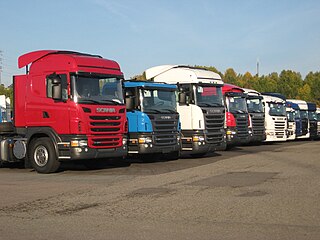
The Scania PRT-range, also referred to as new truck range or Scania's truck range, is the current range of trucks produced by the Swedish commercial vehicle manufacturer Scania. It was first introduced as the successor to the 4-series in spring 2004 with the high forward control cab Scania R-series, followed by the low forward control cab Scania P-series and bonneted cab Scania T-series later in the year. The bonneted model was discontinued in 2005. In 2007 the Scania G-series, a medium forward control cab was introduced and was derived from the R-series. The entire range is modular, giving a wide range of different configurations for different types of trucks. The trucks are available with engines ranging from a 9-litre I5 to a 16-litre V8, with the V8 only being available in the higher model. A second generation launched in August 2016, first was the Scania S-series being the first flat-floor model. In December 2017, a low-end version of the second generation, the Scania L-series, also launched.
